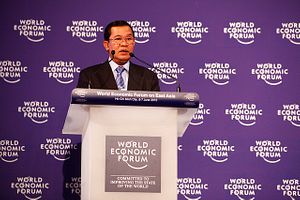The Cambodian economy is struggling. Western donors and businesses are reluctant to invest under the threat of sanctions. And even the country’s largest benefactor, China, is witnessing an unprecedented fall in GDP growth amid a trade war with the United States.
Partly in a bid to offset that and broaden its economic horizons, Phnom Penh is hoping to sign up to a free trade deal with the Eurasian Economic Union (EAEU), which comprises of Armenia, Belarus, Kazakhstan, Kyrgyzstan, and Russia.
As of now, negotiations have barely begun, with an announcement made after the ASEAN economic ministers meeting in Bangkok earlier this month where the focus was on opening up trade between Southeast Asia and the Central Asia-Eastern Europe blocs. But they are nonetheless important to watch.
Rice, silk, textiles, meat, vegetables, and coffee are entitled to EAEU market duty free access over a three-year period. Cambodia is expected to build on that, while taking advantage of precedents set by Vietnam, which has already reached an FTA with the Eurasian trading bloc. Cambodia already enjoys preferential treatment on 46 products due to its status as a least developed country.
The EAEU has a combined population of 183 million and an annual GDP (PPP) of US$5 trillion by one count and sits between China and the European Union.
Trade between EAEU and Vietnam reportedly rose 13 percent a year after the FTA was launched, reaching $6.7 billion. EAEU exports rose 20 percent to $2.7 billion, while imports increased by nine percent to $4 billion. Beyond Vietnam, Singapore is expected to sign off on an FTA with the bloc as well.
Cambodia’s economy has become increasingly insular, with the United States threatening trade sanctions and the European Union warning it will revoke trade preferences in the aftermath of last year’s elections, widely criticized as rigged.
The main political opposition party was banned, its leaders fled or were jailed, independent media was shut down, and dissident voices silenced ahead of a poll that deeply upset pro-democracy advocates and returned Cambodia to one-party rule.
Warning of financial repercussions from the West went unheeded, with Prime Minister Hun Sen opening up his country to a massive influx of Chinese investment.
However, the Chinese economy is now faltering as the trade war with the United States bites and whether Beijing can maintain the current investment rate in Cambodia is doubtful.
“Cambodian agricultural products are a huge necessity for the new market,” Cambodia Chamber of Commerce vice-president Lim Heng said earlier this year. “In such a globalized world, it is good to maintain existing markets and at the same time strive to enter new ones.”
As a result, it is no surprise that we have seen a greater focus on other trade agreements including the EAEU. A memorandum of understanding was signed between Cambodia and the EAEU in 2016 to enhance cooperation. And the prospect of an FTA was again mooted in March, ahead of this month’s ASEAN meetings in Bangkok.
Yet for all the talk about a new agreement, its future prospects remain unclear. Cambodian leaders are expected to travel to Moscow next month to hammer out a deal, government friendly press reported. But as we have seen with other cases of trade deals in the Asia-Pacific, getting to yes can often be a much longer road than all sides expect.
Luke Hunt can be followed on Twitter @lukeanthonyhunt

































